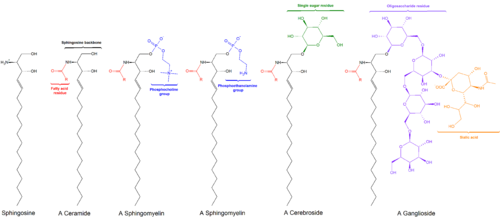
Back شحميات سفينجولية Arabic Сфінгаліпіды BE Сфинголипид Bulgarian Esfingolípid Catalan Sfingolipidy Czech Sphingolipide German Esfingolípido Spanish Esfingolipido EU اسفنگولیپید FA Sfingolipidi Finnish
This article needs additional citations for verification. (January 2023) |

Sphingolipids are a class of lipids containing a backbone of sphingoid bases, which are a set of aliphatic amino alcohols that includes sphingosine. They were discovered in brain extracts in the 1870s and were named after the mythological sphinx because of their enigmatic nature.[1][2] These compounds play important roles in signal transduction and cell recognition.[3] Sphingolipidoses, or disorders of sphingolipid metabolism, have particular impact on neural tissue. A sphingolipid with a terminal hydroxyl group is a ceramide. Other common groups bonded to the terminal oxygen atom include phosphocholine, yielding a sphingomyelin, and various sugar monomers or dimers, yielding cerebrosides and globosides, respectively. Cerebrosides and globosides are collectively known as glycosphingolipids.
- ^ Chun J, Hartung HP (2010). "Mechanism of action of oral fingolimod (FTY720) in multiple sclerosis". Clinical Neuropharmacology. 33 (2): 91–101. doi:10.1097/wnf.0b013e3181cbf825. PMC 2859693. PMID 20061941.
- ^ Schnaar, Ronald L.; Sandhoff, Roger; Tiemeyer, Michael; Kinoshita, Taroh (2022), Varki, Ajit; Cummings, Richard D.; Esko, Jeffrey D.; Stanley, Pamela (eds.), "Glycosphingolipids", Essentials of Glycobiology (4th ed.), Cold Spring Harbor (NY): Cold Spring Harbor Laboratory Press, ISBN 978-1-62182-421-3, PMID 35536927, retrieved 2024-09-10
- ^ Harayama, Takeshi; Riezman, Howard (May 2018). "Understanding the diversity of membrane lipid composition". Nature Reviews. Molecular Cell Biology. 19 (5): 281–296. doi:10.1038/nrm.2017.138. ISSN 1471-0080. PMID 29410529.